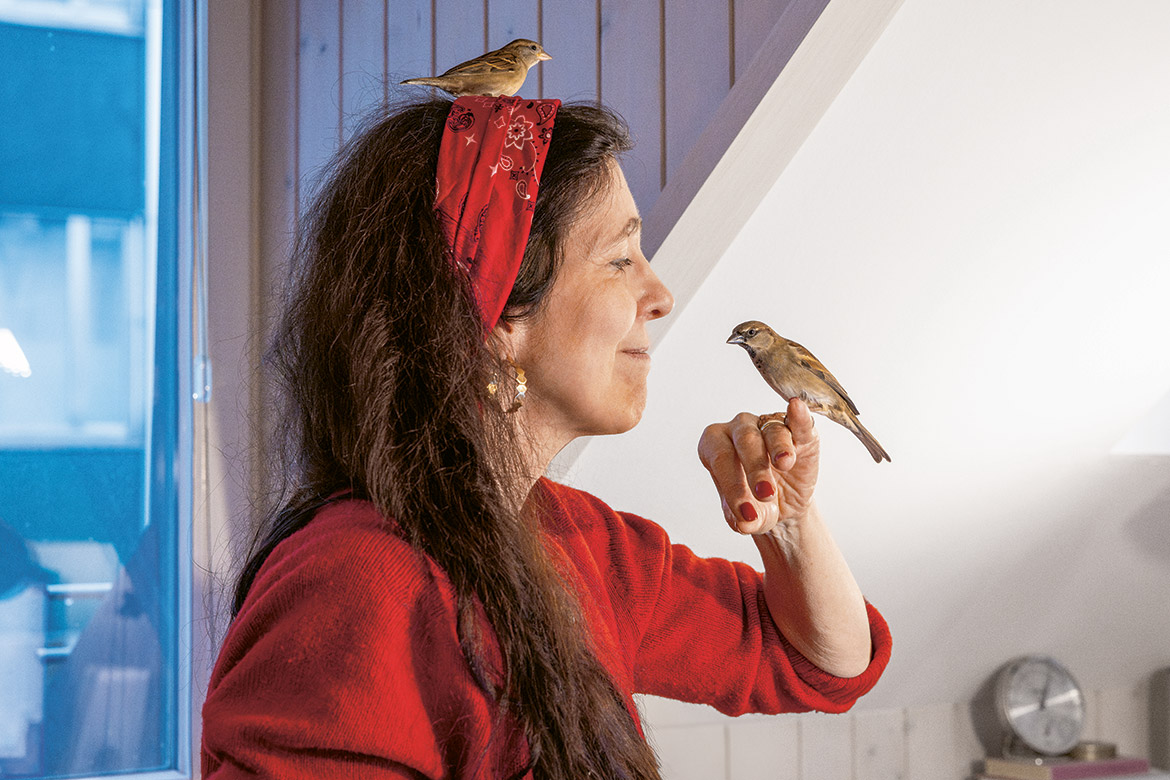ANIMAL TESTING
Moral decisions for the benefit of humans
The ethicist Suzann-Viola Renninger is a member of the Commission on Animal Experimentation of the canton of Zurich. Its task is to weigh up the strain inflicted on animals against the usefulness to humanity of the knowledge we gain from an experiment. We spoke to her about moral issues decided by gut feeling, and about the true victims when dignity is violated.

For the philosopher Suzann-Viola Renninger, the dignity of Creation is clearly an anthropocentric concept. | Photo: Vera Hartmann
Suzann-Viola Renninger, at home, you’ve nursed two sparrows back to health. But as a member of the Commission on Animal Experimentation, you approve transplanting tumours into mice. How do you cope with these apparent contradictions?
My concern in both cases is for the welfare of the animals. But when it comes to treating or curing serious diseases, the welfare of human beings is more important to me. That’s why I am in favour of animal experimentation for medicine and basic research, albeit under specific conditions. So that’s why I can also approve transplanting tumours into mice.
How does the Commission function?
We implement the mandate given to us by our Constitution, which guarantees freedom of research while at the same time demanding that we take the dignity of animals into account. There exists a tension between these two principles as soon as researchers want to carry out experiments on animals. When applications are submitted to the Commission, we first clarify all the technical questions. For example: Is the research up to date? Will the animals be treated well and kept well? Is there adequate pain relief for them? Often, we send applications back to the researchers twice for them to answer our questions. Only when we’re satisfied from a professional point of view do we start to weigh up the different interests involved.
How does such an assessment work? Is it a moral issue on which you simply trust your gut?
If by ‘gut decision’ you mean that one’s whole life experience plays a role in it, then yes. But it’s a gut decision that is well informed. We study the application carefully in every case and discuss the pros and cons. If all the parameters are in order, and if the experiment can provide a building block in getting a better understanding of dementia or cancer, then I believe there’s reason enough to permit the test. For other people, research into dementia or cancer would be a black mark against an application. Any cure for these diseases lies so far in the future that they believe it annuls any justification for testing today. When it comes to weighing up the interests involved, each member of the committee is on their own. Ultimately, it’s the majority who decide.
You’re basically comparing apples with oranges when you weigh up the impact on actual laboratory animals against the rather abstract gains in knowledge for humankind as a whole.
It’s not just about humankind. There are also benefits for veterinary medicine and for protecting the environment. But yes, the basic problem remains. There is no objective scale by which we could measure the strain placed on animals against the knowledge gained, and then compare them numerically. That’s why we talk about weighing up the different interests, not measuring them. We’re taking moral decisions, not mechanical decisions.
Animal rights activists criticise the fact that the rejection rates for applications are in the low, single-digit percentage range.
Looking at the rejection rate is no way to assess the quality of the assessment process. Most of the applications are well formulated, which is why a majority of the Committee finds good reasons to approve them.
In Sweden and at the University of Linz in Austria, laypeople are involved in these ethical assessments. Wouldn’t that also be a good model for Switzerland?
It would be challenging to laypeople because it requires specialist knowledge. For example, you have to be able to judge whether there is an animal-free alternative, whether the number of animals used could be reduced, or whether their living conditions might be improved. Of course, laypeople could be employed to supplement the Commission. But anyone who believes that a committee of laypeople would be more likely to reject applications ought to bear in mind that any such group will also include relatives of seriously ill people.
The Zurich Commission also includes three animal welfare representatives. Is every decision ultimately always these three against the rest?
The law states that the animal welfare organisations have to be represented adequately. What’s special about Zurich is that three members of the Commission can lodge an appeal against the majority decision. This is a remedy that can lead to in-depth, important discussions.
Researchers complain that applications involve too much bureaucracy.
It’s true that the workload of researchers is constantly increasing. They have to plan their experiments very precisely and describe many aspects of them. They also have to weigh up the different interests themselves. I do understand that it can be time-consuming for them, and thus rather tedious. But it’s a process concerned with the welfare of the animals, so they have to live with it. The greater the care they devote to formulating their applications, the fewer queries we’ll have, and the quicker their applications will be processed.
Besides the pain, stress, fear and harm done to the animals, the Commission also has to assess the so-called non-pathocentric strain that they endure. What is this?
That’s no easy question. The concept of the ‘dignity of Creation’ has been anchored in the Swiss Constitution since 1992. The concept of the intrinsic value of animals was derived from this, and this in turn led to the decision that non-pathocentric strain also has to be taken into account. According to the Animal Welfare Act, such strain exists when an animal is excessively instrumentalised. The Federal Food Safety and Veterinary Office mentions as an example the parabiosis that is undertaken when the bodies of two mice are sewn together.
That’s an extreme example. But isn’t a test animal by its very definition instrumentalised?
That’s a very broad interpretation of the term. If you see things that way, then I’m also being instrumentalised right now as your interview partner – and the same would apply to any animal that’s eaten, or kept in a zoo, or as a pet in your home. Whether or not this is excessive is another question. For some people, merely breeding laboratory animals is an act of instrumentalising them. ‘Excessive instrumentalisation’ is also a term that can easily lead to misunderstandings. This is because the legislators don’t mean that an experiment in which animals are ‘excessively instrumentalised’ must automatically be rejected. Applying this concept has led to intensive discussions in the Commission.
What was the result of that?
We developed criteria that all stakeholders – the researchers, the Commission and the public – can use to assess whether or not excessive instrumentalisation is taking place. But the important word here is ‘can’. It’s not a must. This is a moral decision, and it’s impossible to prescribe how such a decision should be taken.
Isn’t the ‘dignity of animals’ an anthropocentric concept that distracts us from their actual suffering?
Of course it’s anthropocentric. Our Commission discusses things without the animals themselves being able to have a say. An animal is more likely to suffer from pain than from a violation of its dignity. It’s us humans who suffer vicariously for the violation of an animal’s dignity. And the concept of the dignity of Creation doesn’t exactly streamline our assessment processes. It can indeed distract us from the actual suffering involved.
Couldn’t the ethical decisions of the Commission on Animal Experimentation be made more transparent?
Anyone can go online and check out the whole process from the application to our final decision. You can look up all the information that we require from the researchers and how we weigh up the different interests involved, including the criteria for excessive instrumentalisation. The Commission’s meetings, however, are confidential. This is so that we can discuss matters freely and objectively. However, our meetings are minuted, so that our decisions are transparent in the event of an appeal being made.




